Adhesion of Modified Epoxy Resin to a Concrete Surface
Abstract
1. Introduction
- Fiber-forming polymers—a group of polymers with reinforcement in the form of fibers (glass, carbon, aramid, basalt, etc.);
- Structural polymers (resin concretes)—used as a construction material in which the cement binder is partially or completely replaced by a polymer;
- Coating polymers:
- (a)
- Hydrophobic (impregnating) polymers in the form of agents applied as coatings are used to protect porous materials;
- (b)
- Paints and varnishes—a group of polymeric compounds used as paint coatings, as a decorative element, for interiors and facades of buildings;
- (c)
- Protective coatings, films—films have become very popular in the construction industry, as materials used to protect other elements, waterproofing, shielding, protective coatings;
- Insulating materials—this group includes Styrofoam, one of the most popular materials currently used for thermal insulation and thermal upgrading of buildings;
- Adhesive polymers (glues)—epoxy, polyester, phenolic, formaldehyde, polyurethane, resins [15,16,17,18,19]; this is a group of polymers which, owing to their very good adhesive properties and high adhesion to various materials, i.e., steel, concrete, wood, ceramics, have found their use for joining or reinforcing elements; adhesives can be used for secondary bonding of reconstructed or detached defects of elements, bonding of layers, also made of different materials; an important feature of adhesives is their quick setting, very good adhesion, low shrinkage and creep and minimal tendency to relax during operation of the bonded joint.
- -
- Method of surface preparation and its parameters, roughness;
- -
- The type of materials to be joined and the structure of their surfaces;
- -
- The type of adhesive used, its method of preparation, modifications carried out in the liquid state and curing;
- -
- The conditions under which the glued joint will operate;
- -
- Mechanical properties of the adhesive and the substrate.
2. Materials and Methods
2.1. Components Used and Mixtures
- BASF microsilica (BASF, Ludwigshafen, Germany), with a density of 2.2 g/cm3, mean particle size of 0.1 µm and a specific surface area of 20,000 m2/kg;
- NanocylTM NC7000 carbon nanotubes (NANOCYL, Sambreville, Belgium) with a density of 1.3–1.4 g/cm3, an average diameter of about 9.5 nm, a length of 1.5 μm and a specific surface area of 250–300 m2/g.
- C—the surface of the concrete cleaned of dust, laitance and other fine dirt with a brush;
- G—concrete surface ground with a diamond disc;
- S—concrete surface wet-sanded with quartz sand with a diameter of 0.1–0.5 mm.
2.2. Methodology
- Measurement of viscosity of unmodified adhesive, measuring the temperature and viscosity of the resin when the sonicator was turned off, after 7 min of sonication;
- Measurement of the temperature and viscosity of the resin at the moment when the resin reached a comparative temperature of 22 °C, at which further processing of the adhesive was performed, at intervals of 5 min between successive measurements;
- Performing tests on the strength parameters of samples made from the described adhesives: surface hardness, tensile strength, elastic modulus, Poisson’s ratio;
- Manufacturing of class C30/37 concrete specimens constituting the substrate for re-gluing the CFRP tape fragments with the selected adhesive;
- Preparation of the surface of the samples according to the accepted methods of concrete surface treatment;
- Gluing the tape fragments to the concrete samples and testing the adhesion of the samples to the concrete substrate using a modified version of the pull-off test;
- SEM analysis of samples extracted from resins;
- Analysis of the obtained results.
2.2.1. Physical Properties
2.2.2. Surface Properties
2.2.3. Mechanical Properties
2.2.4. Microstructural Properties
3. Results and Discussion
3.1. Physical Properties
Viscosity and Density of Unmodified and Modified Adhesive
3.2. Surface Properties
3.3. Mechanical Properties
3.3.1. Tensile Strength, Elastic Modulus and Surface Hardness of Resins
3.3.2. Pull-Off Adhesion
3.4. SEM Analysis of Resin Structure
3.5. Correlation Analysis
4. Conclusions
- The changes in viscosity of the analyzed series were directly due to the type of modifications used. Depending on the condition and type of the substrate and its roughness, it is possible to select the modified adhesive in such a way as to facilitate its penetration into the irregularities of the substrate (on a rough surface).
- Substrate roughness significantly affects the variation of adhesive adhesion results. The significant development of the specific surface of the concrete, which translates into significant roughness, is of great importance. This results in an increase in the proportion of mechanical adhesion. The surface treatment itself also leads to activation of the surface in terms of the distribution of centers containing electron clusters, which can form chemical bonds with the adhesive layer.
- The proportion of adsorption adhesion depends on the type of modification and the substrate. It was significantly higher on the ground and sandblasted surface. Sonication used as a modification and a way to distribute filler molecules in the adhesive leads to reorganization of electrons, which more easily participate in charge exchange with the substrate.
- The EP430/US, EP430/US/MS and EP430/US/NT series were characterized by increased adhesion to concrete substrates modified by mechanical treatment.
- The correlation analysis carried out showed the existence of strong correlations between the mechanical properties of the series studied.
- The described modifications can be successfully used under conditions of practical application in the case of facade cladding, terraces and balconies.
Author Contributions
Funding
Institutional Review Board Statement
Informed Consent Statement
Data Availability Statement
Conflicts of Interest
References
- Rabek, J.F. Współczesna Wiedza O Polimerach; Wydawnictwo Naukowe PWN: Warszawa, Poland, 2013; pp. 8–185. [Google Scholar]
- Young, R.J.; Lovell, P.A. Introduction to Polymers; CRC Press: Boca Raton, FL, USA, 2011. [Google Scholar]
- Mark, J.; Ngai, K.; Graessley, W.; Mandelkern, L.; Samulski, E.; Wignall, G.; Koenig, J. Physical Properties of Polymers; Cambridge University Press: Cambridge, UK, 2004; pp. 10–102. [Google Scholar]
- Szymura, T. Chemia W Inżynierii Materiałów Budowlanych; Wyd. Politechniki Lubelskiej: Lublin, Poland, 2012; pp. 175–206. [Google Scholar]
- Klepka, T. Nowoczesne Materiały Polimerowe I Ich Przetwórstwo; Wyd. Politechniki Lubelskiej: Lublin, Poland, 2014; pp. 15–31. [Google Scholar]
- Hyla, I.; Śleziona, J. Kompozyty, Elementy Mechaniki I Projektowania; Wyd. Pol. Śl.: Gliwice, Poland, 2004. [Google Scholar]
- Czarnecki, L. Betony Żywiczne; Arkady: Warszawa, Poland, 1982; pp. 10–59. [Google Scholar]
- Łukowski, P. Modyfikacja betonu polimerami. Inżynieria Materiałowa 2011, 32, 107–114. [Google Scholar]
- Czarnecki, L. Betony polimerowe—Stan obecny i wyzwania badawcze. Cement Wapno Beton 2002, 7, 106–113. [Google Scholar]
- Krzywobłocka-Laurów, R. Hydrofobizacja wyrobów budowlanych. Prace Instytutu Techniki Budowlanej 2007, 36, 17–46. [Google Scholar]
- Barnat-Hunek, D. Hydrofobizacja Opoki Wapnistej W Obiektach Zabytkowych Kazimierza Dolnego; Wydawnictwo Politechniki Lubelskiej: Lublin, Poland, 2010. [Google Scholar]
- Jakub, J. Budowlane materiały izolacyjne. Budownictwo O Zoptymalizowanym Potencjale Energetycznym 2015, 2, 39–44. [Google Scholar]
- Guzal, J. Styropian. Izolacje 2001, 6, 52–55. [Google Scholar]
- Kelar, K.; Ciecielska, D. Fizykochemia polimerów. Wybrane zagadnienia; Wyd. Politechniki Poznańskiej: Poznań, Poland, 1997. [Google Scholar]
- Rudawska, A. Wybrane Zagadnienia Konstytuowania Połączeń Adhezyjnych Jednorodnych I Hybrydowych; Wyd. Politechniki Lubelskiej: Lublin, Poland, 2013; pp. 13–52. [Google Scholar]
- Godzimirski, J. Problemy klejenia konstrukcyjnego. Technologia i Automatyzacja Montażu 2009, 1, 25–31. [Google Scholar]
- Mirski, Z.; Piwowarczyk, T. Historia klejenia—Od prehistorii do dzisiaj. Przegląd Spawalnictwa 2008, 8, 3–11. [Google Scholar]
- Rudawska, A. Wpływ sposobu przygotowania powierzchni na wytrzymałość połączeń klejowych blach ze stali odpornej na korozję. Technologia i Automatyzacja Montażu 2010, 3, 36–39. [Google Scholar]
- Pilawka, R.; Spychaj, T. Kleje epoksydowe z nanocząstkami do łączenia metali. Kompozyty 2004, 4, 34–36. [Google Scholar]
- Auras, M.; Bundschuh, P.; Eichhorn, J.; Kirchner, D.; Mach, M.; Seewald, B.; Scheuvens, D.; Snethlage, R. Salt deposition and soiling of stone facades by traffic-induced immissions. Environmental Earth Sciences 2018, 77, 1–16. [Google Scholar] [CrossRef]
- Brimblecombe, P. Environment and Architectural Stone. Stone in Architecture; Springer: Berlin/Heidelberg, Germany, 2014; pp. 317–347. [Google Scholar]
- Ksit, B.; Horbik, D. Zanieczyszczenia biologiczne elewacji. Builder 2015, 19, 80–83. [Google Scholar]
- Rokiel, M. Tarasy i balkony. In Projektowanie I Warunki Techniczne Wykonania I Odbioru Robót; DW Medium: Warszawa, Poland, 2012. [Google Scholar]
- Niedostatkiewicz, M. Usterki wilgotnościowe w obszarze wewnętrznego patio komunikacyjnego jako następstwo sposobu eksploatacji oraz błędów projektowych i wykonawczych. Przegląd Budowlany 2014, 85, 33–37. [Google Scholar]
- Drdácký, M. Testing efficiency of stone conservation treatments. In Advanced Materials for the Conservation of Stone; Springer: Cham, Switzerland, 2018; pp. 175–184. [Google Scholar]
- Barnat-Hunek, D.; Smarzewski, P.; Suchorab, Z. Effect of hydrophobisation on durability related properties of ceramic brick. Constr. Build. Mater. 2016, 111, 275–285. [Google Scholar] [CrossRef]
- Jacobs, J.W.; McMullin, P.W. Cladding. In Special Structural Topics; Routledge: London, UK, 2017; pp. 175–206. [Google Scholar]
- de Sousa Camposinhos, R. Stone Cladding Engineering; Springer Science & Business Media: Berlin/Heidelberg, Germany, 2014. [Google Scholar]
- Messler, R.W. Joining of Materials and Structures: From Pragmatic Process to Enabling Technology; Butterworth-Heinemann: Oxford, UK, 2004. [Google Scholar]
- Wojtczak, E. Budownictwo Ogólne W Ujęciu Tradycyjnym; Politechnika Gdańska: Gdańsk, Poland, 2019. [Google Scholar]
- Kinloch, A.J. Adhesion and Adhesives: Science and Technology; Springer Science & Business Media: Berlin/Heidelberg, Germany, 2012. [Google Scholar]
- Ehrenstein, G. Materiały Polimerowe: Struktura, Właściwości, Zastosowanie; Wyd. Naukowe PWN: Warszawa, Poland, 2016; pp. 5–38. [Google Scholar]
- Barnat-Hunek, D. Swobodna Energia Powierzchniowa Jako Czynnik Kształtujący Skuteczność Hydrofobizacji W Ochronie Konstrukcji Budowlanych; Wyd. Politechniki Lubelskiej: Lublin, Poland, 2016; pp. 23–33, 39–59. [Google Scholar]
- Hameed, N.; Thomas, S.; Abraham, R.; Thomas, S. Morphology and contact angle studies of poly(styrene-co-acrylonitrile) modified epoxy resin blends and their glass fibre reinforced composites. Express Polym. Lett. 2007, 1, 345–355. [Google Scholar] [CrossRef]
- Chen, J.; Chen, Y.; Li, H.; Lai, S.Y.; Jow, J. Physical and chemical effects of ultrasound vibration on polymer melt in extrusion. Ultrason. Sonochemistry 2010, 17, 66–71. [Google Scholar] [CrossRef]
- DeVries, K.L.; Adams, D.O. Mechanical testing of adhesive joints. Chapter 6. In The Mechanics of Adhesion; Adhesion Science and Engineering—1; Elsevier Science: Amsterdam, The Netherlands, 2002. [Google Scholar]
- Wypych, G. Handbook of Fillers; ChemTec Pub.: Toronto, ON, Canada, 2010. [Google Scholar]
- Ash, M. Handbook of Fillers, Extenders, and Diluents; Synapse Info Resources: Endicott, NY, USA, 2007. [Google Scholar]
- Park, J.-J. Effect of nanosilica on the mechanical properties and AC electrical breakdown strength of epoxy/microsilica/nanosilica comKiposite. Trans. Electr. Electron. Mater. 2012, 13, 301–304. [Google Scholar] [CrossRef][Green Version]
- Antosik, A.K.; Ragańska, P.; Czech, Z. Termiczne sieciowanie samoprzylepnych klejów silikonowych nadtelenkami organicznymi. Polimery 2014, 59, 792–797. [Google Scholar] [CrossRef]
- Żenkiewicz, M. Wybrane zagadnienia modyfikowania materiałów polimerowych za pomocą promieniowania elektronowego o dużej energii. Polimery 2005, 50, 4–9. [Google Scholar]
- McBain, J.W.; Hopkins, D.J. On adhesives and adhesive action. J. Phys. Chem. 1925, 29, 188–204. [Google Scholar] [CrossRef]
- Zaleski, K.; Matuszak, J.; Zaleski, R. Metrologia Warstwy Wierzchniej; Wyd. PL: Lublin, Poland, 2018; pp. 10–44. [Google Scholar]
- Rudawska, A. Przygotowanie Powierzchni Do Klejenia Wybranych Materiałów Konstrukcyjnych; Wyd. Politechniki Lubelskiej: Lublin, Poland, 2017; pp. 15–133. [Google Scholar]
- Kłonica, M.; Kuczmaszewski, J. Badania Stanu Energetycznego Warstwy Wierzchniej Wybranych Materiałów Konstrukcyjnych Po Ozonowaniu; Wyd. Politechniki Lubelskiej: Lublin, Poland, 2018; pp. 13–60. [Google Scholar]
- Czajka, P.; Mizak, W.; Galas, J.; Czyżewski, A.; Kochanowski, M.; Litwin, D.; Socjusz, M. Profilometr laserowy do odtwarzania geometrii powierzchni. Przegląd Elektrotechniczny 2014, 8, 152–156. [Google Scholar] [CrossRef]
- Marszałek, K.W.; Jaglarz, J. Skanowania optyczne powierzchni jako narzędzia oceny ilościowej i jakościowej powierzchni warstw i powłok. Elektronika: Konstrukcje, Technologie, Zastosowania 2014, 55, 23–26. [Google Scholar]
- Chinga, G.; Gregersen, O.; Dougherty, B.; Anal, M. Paper surface characterisation by laser profilometry and image analysis. Microsc. Anal. 2003, 96, 21–24. [Google Scholar]
- Smith, G.C. Surface Analysis by Electron Spectroscopy. In Surface Analysis by Electron Spectroscopy; Springer: Boston, MA, USA, 1994; pp. 3–14. [Google Scholar]
- Pizzi, A.; Mittal, K.L. Handbook of Adhesive Technology; CRC Press: Boca Raton, FL, USA, 2018. [Google Scholar]
- Zhou, S.; Vu-Bac, N.; Arash, B.; Zhu, H.; Zhuang, X. Interface characterization between polyethylene/silica in engineered cementitious composites by molecular dynamics simulation. Molecules 2019, 24, 1497. [Google Scholar] [CrossRef] [PubMed]
- Zhuang, X.; Zhou, S. Molecular dynamics study of an amorphous polyethylene/silica interface with shear tests. Materials 2018, 11, 929. [Google Scholar] [CrossRef] [PubMed]
- Szewczak, A.; Szeląg, M. Physico-mechanical and rheological properties of epoxy adhesives modified by microsilica and sonication process. Materials 2020, 13, 5310. [Google Scholar] [CrossRef] [PubMed]
- Barnat-Hunek, D.; Góra, J.; Brzyski, P. Ocena skuteczności hydrofobizacji powierzchniowej betonu. Izolacje 2013, 18, 36–42. [Google Scholar]
- Koniorczyk, M. Hydrofobizacja w masie. Cz. 1, Wpływ domieszek krzemoorganicznych na właściwości wilgotnościowe zapraw i zaczynów cementowych. Izolacje 2019, 24, 96–99. [Google Scholar]
- PN-EN 206-1; Beton—Część 1: Wymagania, Właściwości, Produkcja i Zgodność. Wersja Polska: Warsaw, Poland, 2003.
- PN–EN 12390-13-2014-02; Badania Betonu. Część 13: Wyznaczanie Siecznego Modułu Sprężystości przy Ściskaniu. Wersja Polska: Warsaw, Poland, 2014.
- PN EN ISO 527-1; Plastics—Determination of Tensile Properties—Part 1: General Principles. ISO: Geneva, Switzerland, 2019.
- PN EN ISO 527-2; Plastics—Determination of Tensile Properties—Part 2: Test Conditions for Moulding and Extrusion Plastics. ISO: Geneva, Switzerland, 2019.
- Szewczak, A. Influence of Epoxy Glue Modification on the Adhesion of CFRP Tapes to Concrete Surface. Materials 2021, 14, 6339. [Google Scholar] [CrossRef]
- Feng, H.; Yang, W.; Hielscher, T. Power ultrasound. Food Sci. Technol. Int. 2008, 14, 433–436. [Google Scholar] [CrossRef]
- Habchi, C. A gibbs energy relaxation (GERM) model for cavitation simulation. At. Sprays 2015, 25, 317–334. [Google Scholar] [CrossRef]
- Sitka, A.; Sitka, A.; Redzicki, R. Kawitacja w płynach lepkich i lepkosprężystych. Inżynieria Chemiczna i Procesowa 2006, 27, 847–857. [Google Scholar]
- Shimpi, N.; Mali, A.; Hansora, D.P.; Mishra, S. Synthesis and surface modification of calcium carbonate nanoparticles using ultrasound cavitation technique. Nanosci. Nanoeng. 2015, 3, 8–12. [Google Scholar] [CrossRef]
- Wójs, K. Kawitacja w Cieczach o Różnych Właściwościach Reologicznych; Oficyna Wydawcznicza Politechniki Wrocławskiej: Wrocław, Poland, 2004. [Google Scholar]
- Dutkiewicz, E.T. Fizykochemia Powierzchni. In Wykłady z Chemii Fizycznej; WNT: Warszawa, Poland, 1998. [Google Scholar]
- Aggelis, D.; Paipetis, A. Monitoring of resin curing and hardening by ultrasound. Constr. Build. Mater. 2012, 26, 755–760. [Google Scholar] [CrossRef]
- DeSutter, T.; Prunty, L.; Bell, J. Concrete grinding residue characterization and influence on infiltration. J. Environ. Qual. 2011, 40, 242–247. [Google Scholar] [CrossRef]
- Santos, P.; Júlio, E.N.B.S. A state-of-the-art review on roughness quantification methods for concrete surfaces. Constr. Build. Mater. 2013, 38, 912–923. [Google Scholar] [CrossRef]
- Gadelmawla, E.S.; Koura, M.M.; Maksoud, T.M.; Elewa, I.M.; Soliman, H.H. Roughness parameters. J. Mater. Process. Technol. 2002, 123, 133–145. [Google Scholar] [CrossRef]
- Bannov, A.G.; Nazarenko, O.B.; Maksimovskii, E.A.; Popov, M.V.; Berdyugina, I.S. Thermal behavior and flammability of epoxy composites based on multi-walled carbon nanotubes and expanded graphite: A comparative study. Appl. Sci. 2020, 10, 6928. [Google Scholar] [CrossRef]
- Koziol, M.; Jesionek, M.; Szperlich, P. Addition of a small amount of multiwalled carbon nanotubes and flaked graphene to epoxy resin. J. Reinf. Plast. Compos. 2017, 36, 640–654. [Google Scholar] [CrossRef]
- Majeed, A.H. Enforcement of epoxy with silica fume and carbon fiber. Tikrit J. Eng. Sci. 2018, 25, 74–77. [Google Scholar] [CrossRef]
- Montazeri, A.; Chitsazzadeh, M. Effect of sonication parameters on the mechanical properties of multi-walled carbon nanotube/epoxy composites. Mater. Des. 2015, 56, 500–508. [Google Scholar] [CrossRef]
- Czarnecki, S.; Hoła, J. Evaluation of the height 3D roughness parameters of concrete substrate and the adhesion to epoxy resin. Int. J. Adhes. Adhes. 2016, 67, 3–13. [Google Scholar] [CrossRef]
- Djouani, F.; Connan, C.; Delamar, M.; Chehimi, M.M.; Benzarti, K. Cement paste–epoxy adhesive interactions. Constr. Build. Mater. 2011, 25, 411–423. [Google Scholar] [CrossRef]
- Fic, S. Adhezja I Samoorganizacja Struktury Materiału W Tworzeniu Konstrukcji; Wyd. Politechniki Lubelskiej: Lublin, Poland, 2019; pp. 5–120. [Google Scholar]

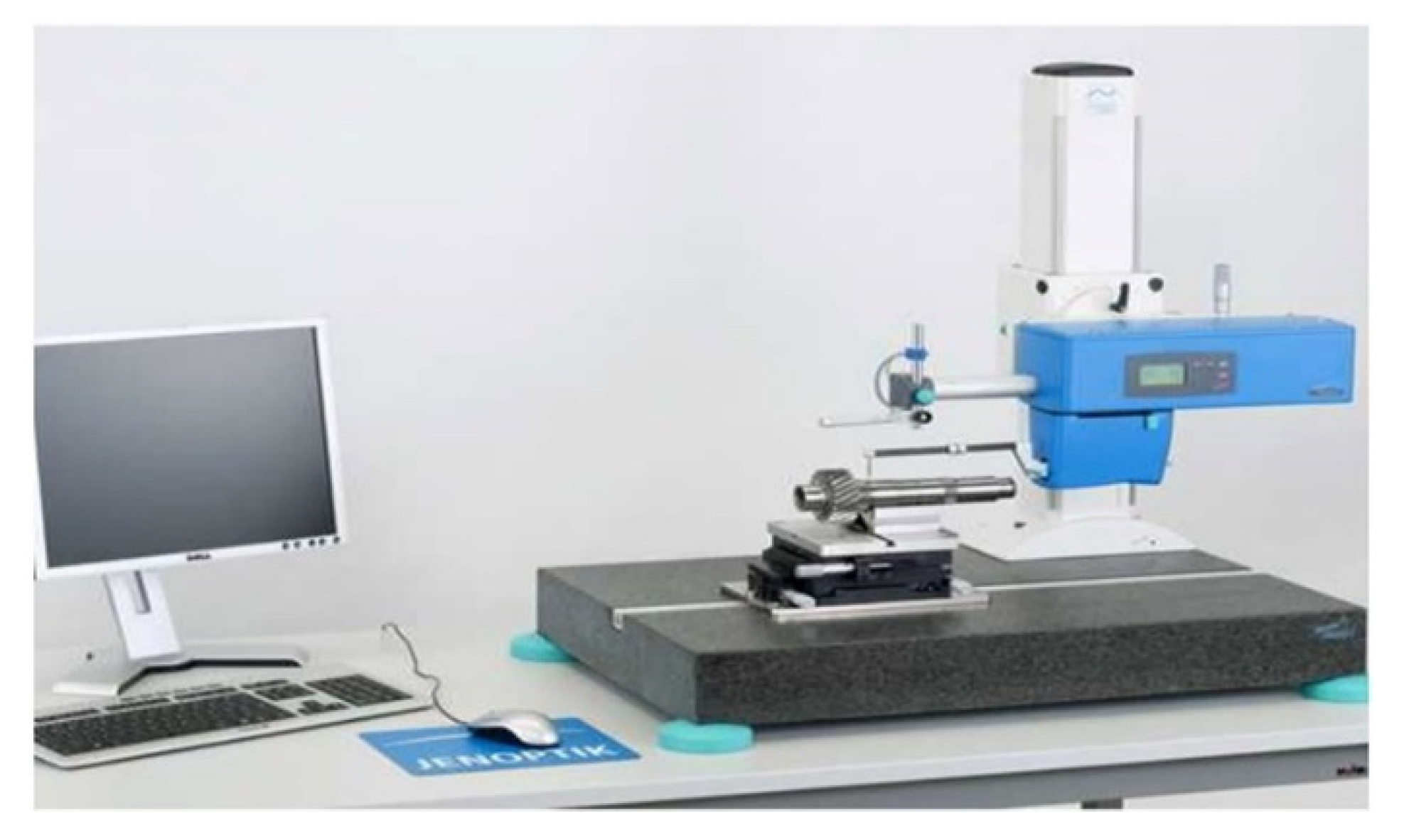


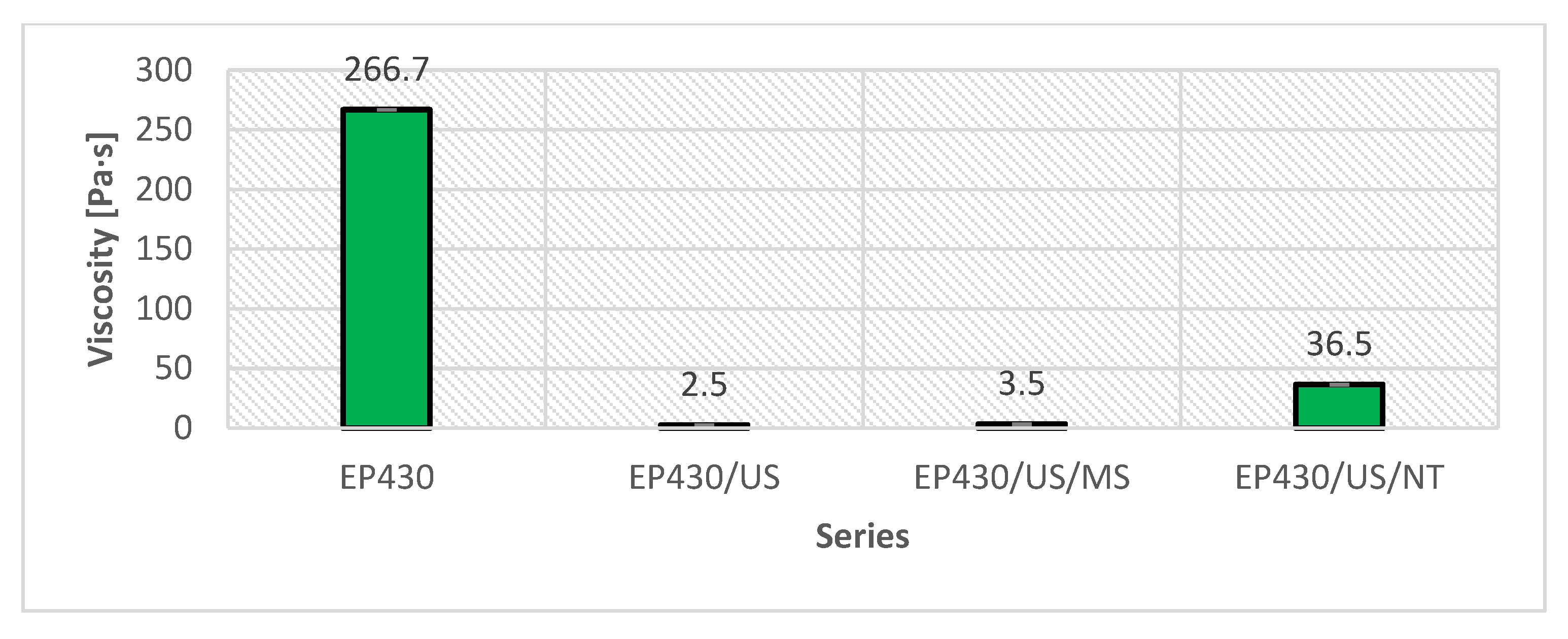
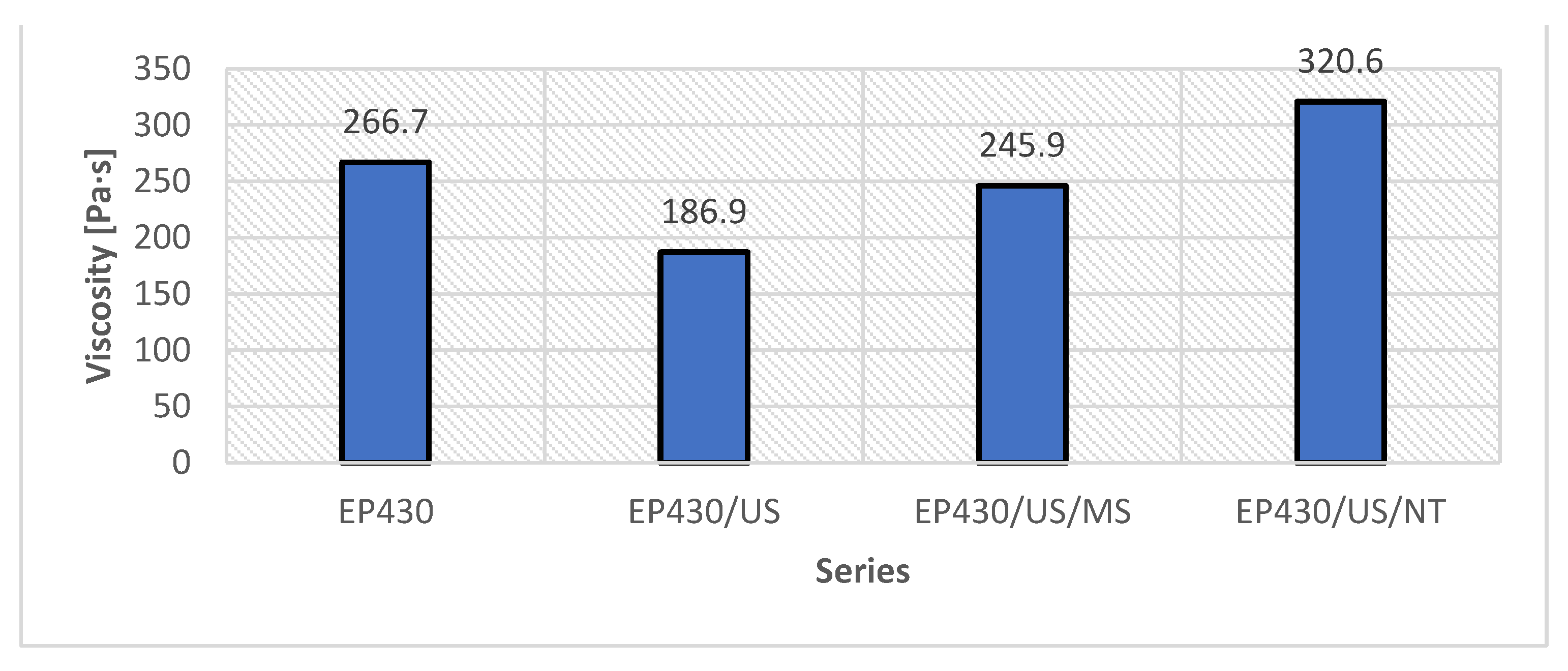
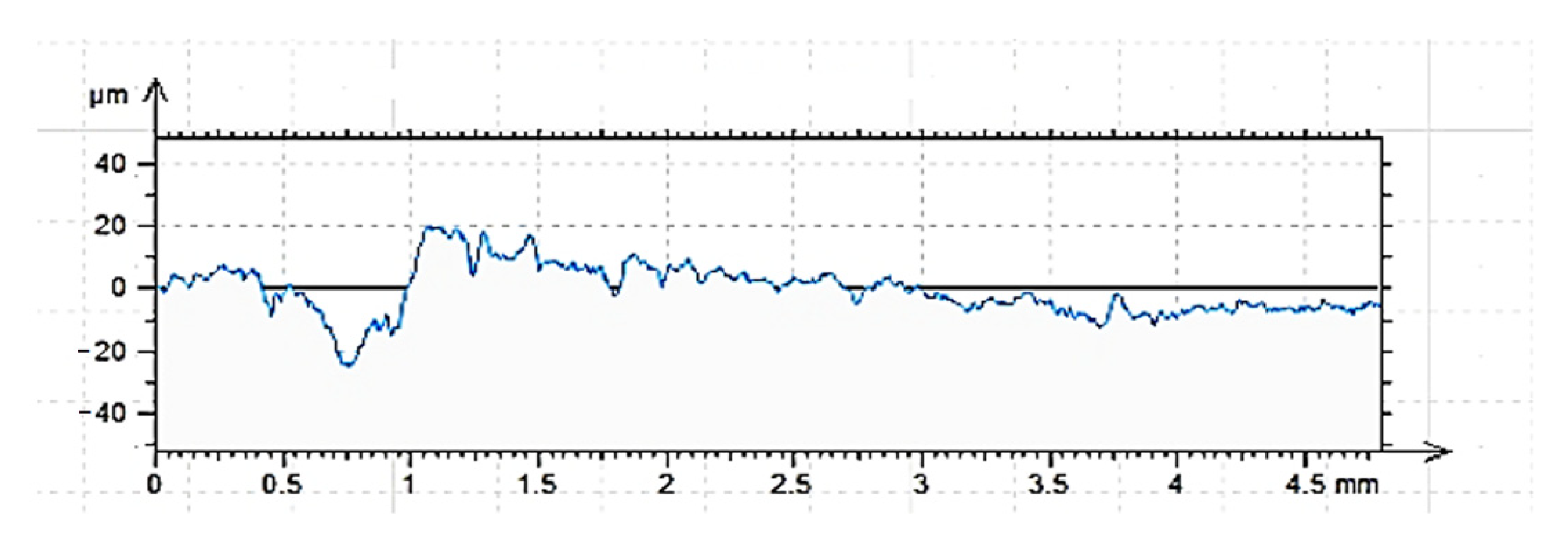


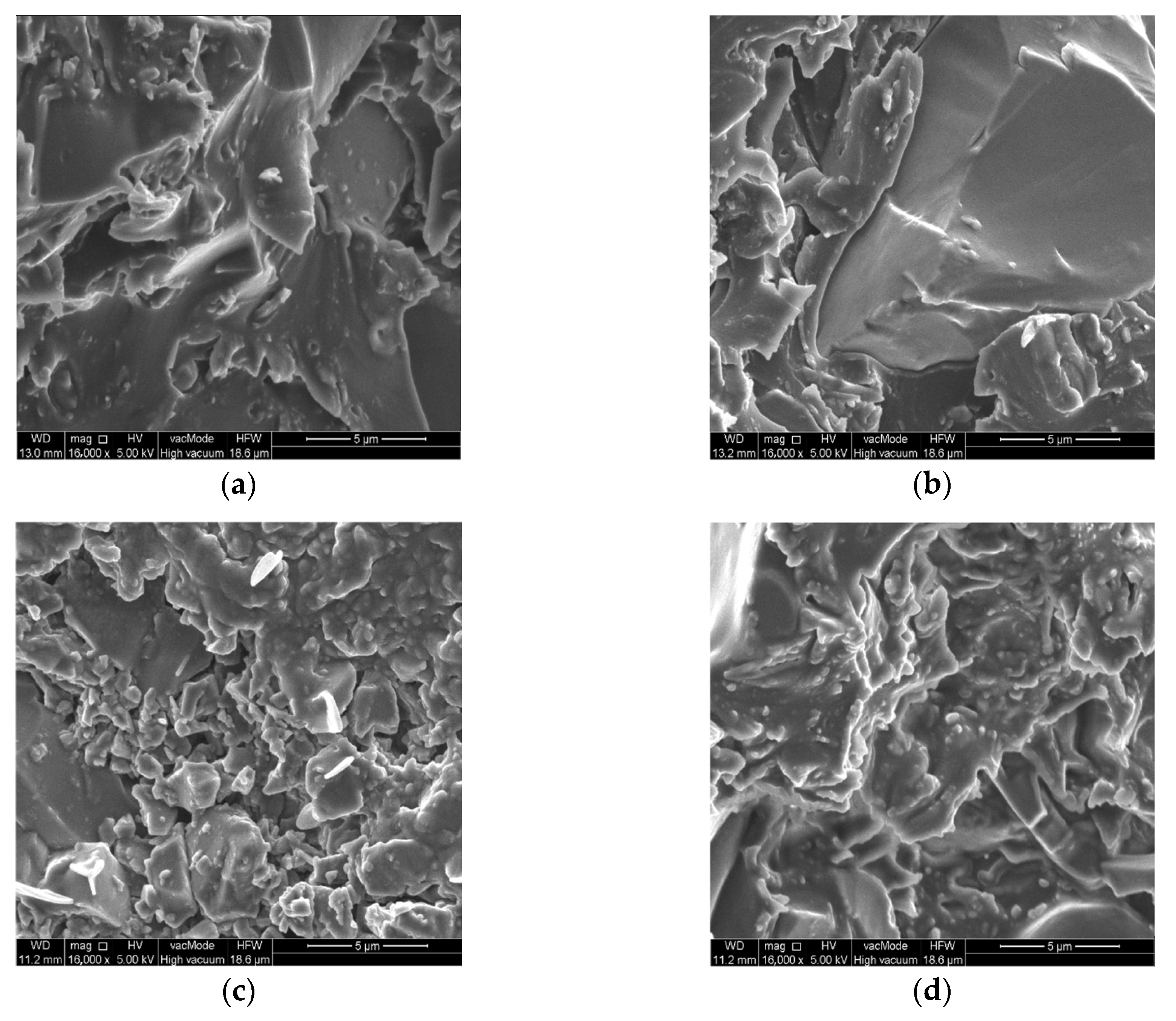
| Resin | EP430 |
|---|---|
| Form | gray mass with the addition of quartz flour |
| Flashpoint (°C) | 170 |
| Gelation time (min) | 120 |
| Epoxy number (mol/100 g) | <700 |
| Density (in 22 °C) (g/cm3) | 2.05 |
| Viscosity (in 22 °C) (Pa·s) | 200 |
| Solubility | ketones, esters, alhohols |
| Chemical resistance to | tap water, sodium hydroxide, hydrochloric acid, concentrated hydrochloric acid, sulfiric acid, nitric acid, acetic acid, xylene, ethanol |
| Series | Resin Type | Type of Additive/Modification | Amount of Filler (%) | Amount of Hardener (%) |
|---|---|---|---|---|
| EP430 | epoxy | — | — | 3 |
| ER430/US | sonication | — | 3 | |
| ER430/US/MS | sonication + microsilica | 0.5 | 3 | |
| EP430/US/NT | sonication + carbon nanotubes | 0.1 | 3 |
| Surface | Rp | Rv | Rz | Rc | Rt | Ra | Rq | Rsm | Rsk | Rku |
|---|---|---|---|---|---|---|---|---|---|---|
| C | 7.04 | 7.9 | 14.9 | 7.2 | 26.5 | 2.77 | 3.46 | 0.144 | −0.107 | 3 |
| G | 12.6 | 17.1 | 29.7 | 16 | 45 | 5.66 | 6.96 | 0.149 | −0.421 | 2.7 |
| S | 15.5 | 21.1 | 36.5 | 22.6 | 47.4 | 6.95 | 8.74 | 0.3 | −0.467 | 2.89 |
| Series | EP430 | ν* (%) | EP430/US | ν (%) | EP430/US/MS | ν (%) | EP430/US/NT | ν (%) |
|---|---|---|---|---|---|---|---|---|
| Hardness HV10 | 23.0 | 2.0 | 21.5 | 3.0 | 26.3 | 2.1 | 16.0 | 1.8 |
| Tensile strength ft.ax (MPa) | 19.6 | 3.4 | 32.5 | 2.8 | 20.1 | 2.5 | 19.8 | 1.5 |
| Elasticity modulus Et (GPa) | 8.8 | 1.6 | 9.3 | 2.3 | 9.0 | 3.4 | 8.9 | 1.2 |
| Series | Force (kN) | Pull-Off Stress (MPa) | Coefficient of Variation (%) |
|---|---|---|---|
| EP430 | 2.5 | 3.3 | 1.0 |
| EP430/US | 2.4 | 3.2 | 1.0 |
| EP430/US/MS | 2.2 | 2.9 | 4.1 |
| EP430/US/NT | 1.2 | 1.6 | 3.2 |
| Series | Force (kN) | Pull-Off Stress (MPa) | Coefficient of Variation (%) |
|---|---|---|---|
| EP430 | 2.8 | 3.7 | 1.2 |
| EP430/US | 3.1 | 4.1 | 3.0 |
| EP430/US/MS | 3.4 | 4.5 | 1.4 |
| EP430/US/NT | 3.1 | 4.1 | 4.8 |
| Series | Force (kN) | Pull-Off Stress (MPa) | Coefficient of Variation (%) |
|---|---|---|---|
| EP430 | 3.0 | 4.0 | 2.1 |
| EP430/US | 3.6 | 4.8 | 3.1 |
| EP430/US/MS | 4.5 | 6.1 | 1.3 |
| EP430/US/NT | 3.5 | 4.7 | 3.6 |
| Pearson’s Correlations (r) | ||||||||
|---|---|---|---|---|---|---|---|---|
| Viscosity | HV10 | ft.ax | Et | fb C | fb G | fb S | ||
| Spearman’s correlations (ρ) | Viscosity | --- | −0.54 | −0.83 | −0.82 | −0.78 | −0.15 | 0.49 |
| HV10 | 0.40 | --- | −0.02 | 0.09 | 0.78 | 0.31 | 0.49 | |
| ft.ax | −0.40 | 0.80 | --- | 0.94 | 0.38 | 0.03 | −0.04 | |
| Et | 0.40 | 0.40 | 0.40 | --- | 0.62 | −0.51 | −0.33 | |
| fb C | 0.01 | 0.80 | −0.02 | 0.09 | --- | 0.31 | 0.60 | |
| fb G | −0.60 | 0.80 | 0.94 | 0.94 | 0.38 | --- | −0.04 | |
| fb S | 0.40 | 0.40 | 0.40 | 0.38 | 0.28 | 0.38 | --- | |
Publisher’s Note: MDPI stays neutral with regard to jurisdictional claims in published maps and institutional affiliations. |
© 2022 by the authors. Licensee MDPI, Basel, Switzerland. This article is an open access article distributed under the terms and conditions of the Creative Commons Attribution (CC BY) license (https://creativecommons.org/licenses/by/4.0/).
Share and Cite
Szewczak, A.; Łagód, G. Adhesion of Modified Epoxy Resin to a Concrete Surface. Materials 2022, 15, 8961. https://doi.org/10.3390/ma15248961
Szewczak A, Łagód G. Adhesion of Modified Epoxy Resin to a Concrete Surface. Materials. 2022; 15(24):8961. https://doi.org/10.3390/ma15248961
Chicago/Turabian StyleSzewczak, Andrzej, and Grzegorz Łagód. 2022. "Adhesion of Modified Epoxy Resin to a Concrete Surface" Materials 15, no. 24: 8961. https://doi.org/10.3390/ma15248961
APA StyleSzewczak, A., & Łagód, G. (2022). Adhesion of Modified Epoxy Resin to a Concrete Surface. Materials, 15(24), 8961. https://doi.org/10.3390/ma15248961







